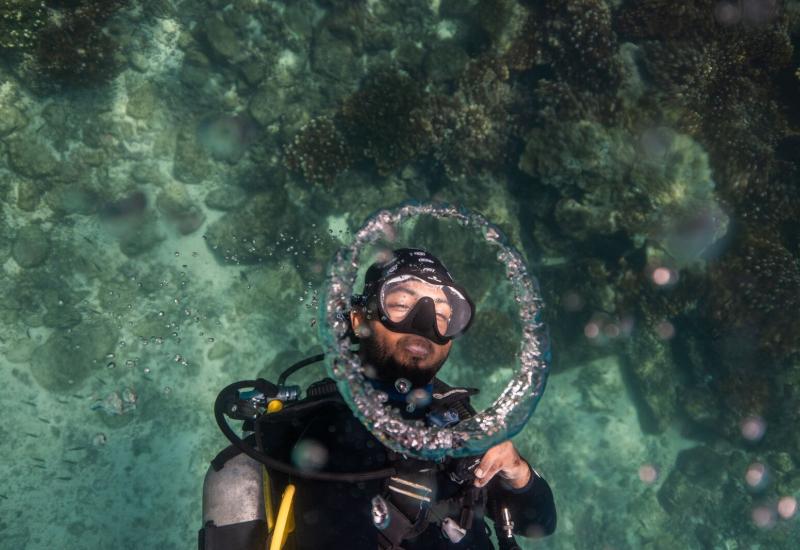Where to Scuba Dive in South Florida

Jennifer IdolSpadefish school beneath Blue Heron Bridge.
The astounding variety of diving in South Florida offers an ocean of hope and adventure for all divers. With so many dive sites, shops and charters to choose from, the biggest challenge can be identifying what dives to plan. Count on finding somewhere to dive year-round, though summer provides the most reliable weather.
When visiting South Florida sites, I prefer to begin in West Palm Beach, where the most notable shore dive in the United States is found. Blue Heron Bridge is open year-round during high tide, and is protected from winter waves.
Macro photography dominates at the bridge because it’s a nursery that brings in a wide variety of tropical life, from seahorses to pufferfish and frogfish. Manatees and sharks can be seen on early morning dives, and schooling angelfish provide another wide-angle opportunity.
After shore diving, head offshore with charters from operators like South Florida Diving Headquarters in Pompano Beach to dive wrecks such as the Lady Luck, a large sludge tanker decorated as a casino. This is one of the largest wrecks in South Florida’s artificial reef system. Book a charter with Sea Experience to tour Fort Lauderdale’s wreck trek, a drift dive between the Jay Scutti and the Merci Jesus. Black-water diving in Fort Lauderdale is a great way to complete a full dive day. At night, numerous and varying bioluminescent invertebrates and juvenile fish rise from the depths. Tethered divers hover in groups for these macro night dives.
Shark diving has also become very popular just a few miles offshore, at the edge of the Gulf Stream, where operators attract sharks with bait. Head north to Jupiter to dive with sharks or goliath grouper on a drift dive. Complete your trip on reef ledges for a final natural look at reef sharks, sea turtles and moray eels.
Dive Sites

PADI StaffSouth Florida has something for every diver.
Jupiter Drift Diving
Full-service dive centers such as Scuba Works can help you book a charter with goliath grouper or even a specialty sawfish dive. Wildlife may include sharks, rays and sea turtles, but it is the goliath grouper, which aggregate here in late summer to spawn, that are the most notable subject.
Blue Heron Bridge
At Phil Foster Park, Blue Heron Bridge offers three distinct experiences teeming with macro life. Outside the swim area, nudibranchs, seahorses, octopuses and mantis shrimp live among the sea grass. Blennies, shrimp and flying gurnards inhabit the boat channel. The eastern side offers towering views of the bridge structure.
M/V Castor
Combine wreck diving with the goliath grouper aggregation, especially in August, on a charter with Splashdown Divers in Boynton Beach. Tubastraea and other stony corals cover the exterior of this deep wreck. Hide from current by penetrating the bow or staying low along the profile of the collapsed center section.
Wreck Photo Tips

Jennifer IdolA diver inspects part of the 324-foot tanker Lady Luck sunk near the coast off Pompano Beach.
1. Working in Low Visibility
While visibility is generally good inside wrecks before divers disrupt rust with their bubbles, it is unpredictable for exterior photos and must be pristine to capture an entire wreck. In normal conditions, plan to capture smaller sections of wreck that are interesting and recognizable as ship features, such as the wheelhouse or propellers.
2. Determine the Mood
Wrecks may depict a haunting image or appear majestic and bright, depending on how light is used. Photos looking up toward the sun create bright rays that appear more cheerful than photos that use silhouettes. Consider where the sun lies in relation to the wreck and your subject to create a mood.
3. Find Your Subject
Wrecks themselves are a subject, but they also attract an abundance of wildlife. Dive buddies also make great models to add context to the scale of wrecks. Interior shots require familiarity with the ship and planning to light them (and of course, the proper training and equipment for penetration). Divemasters can guide divers to their desired subjects.
Need to Know
Conditions
Viz typically falls between 30 and 75 feet, with water temperatures around 69 to 87 degrees from winter to late summer.
What to Wear










